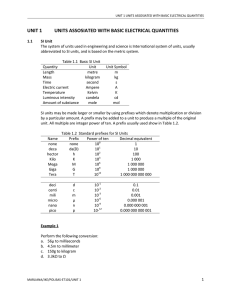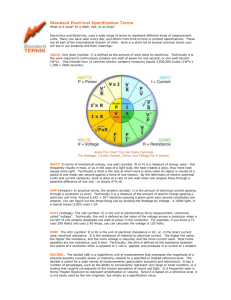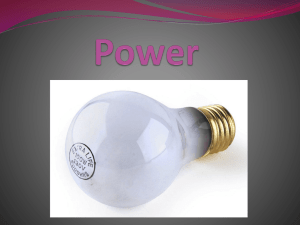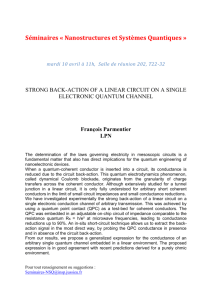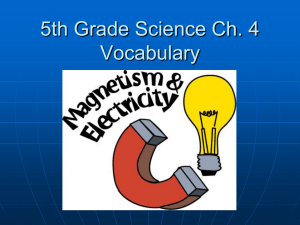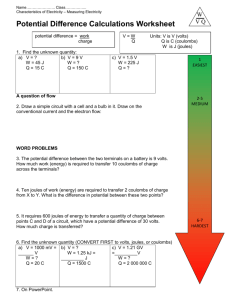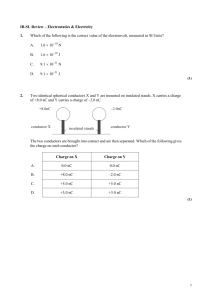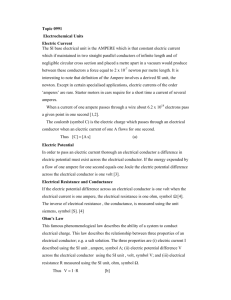Example 1 - WordPress.com
advertisement
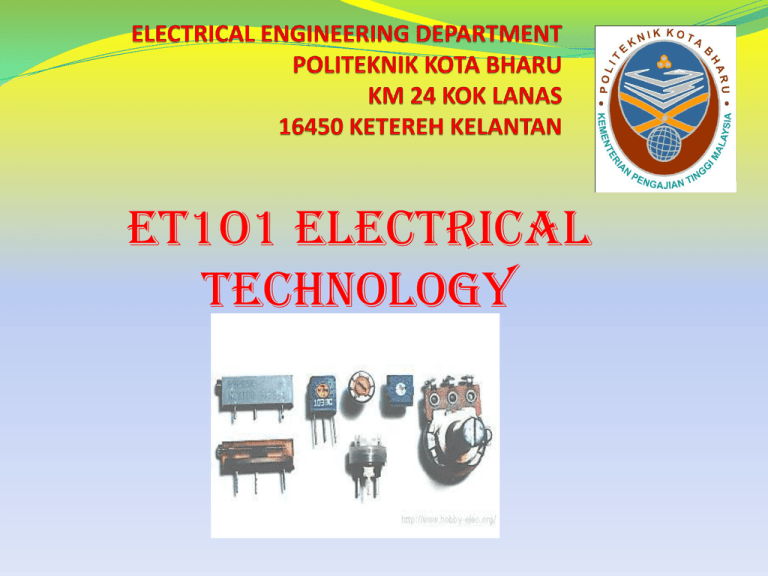
ET1O1 ELECTRICAL TECHNOLOGY INTRODUCTION ET101 Electrical Technology course introduces students to the principles of Operation of DC electrical circuit. It covers the fundamental laws, theorems and circuit techniques. It also cover cell and batteries, magnetic and electromagnetic circuit. COURSE LEARNING OUTCOMES (CLO) Upon completion of this course, students should be able to: 1. Explain DC circuit concepts and their analyses with different method and approach. (C2) 2. Apply the knowledge of DC circuit laws and theorems in solving problem related to DC electrical circuit. (C3) 3. Use appropriate components and measuring equipment to perform related DC electrical circuit laboratory exercises. (P4) 4. Demonstrate team working efficiency while doing practical work. (A3 CHAPTER 1.0 UNIT ASSOCIATED WITH BASIC ELECTRICAL QUANTITIES INTRODUCTION The system of units used in engineering and science is the International system of units usually abbreviated to SI units., and is based on the metric system. This was introduced in 1960 and is now adopted by majority of countries as the official system of measurement 1.2: Prefixes to Signify Powers of 10. - SI units may be made larger or smaller by using prefixes which denote multiplication or division by a particular amount. - The prefixes power of ten are listed as in the Table. Examples of Final Examination Questions ; 1.1/ 1000 in power of ten is 2. Convert 5mA to microamperes (µA) 3.Convert 10 kΩ to megaohms (MΩ) 4.Give the power of ten for micro Examples ; Express 2.1 V in millivolts (mV). Convert 4500 microvolts (μV) to milivolts (mV). Exercise 1) Convert : a) 356 mV to volts (V). b) 500 000 Ω to megaohms (M Ω). c) 20 000 000 picofarads (pF) into farads (F). d) 47 000 picofarads (pF) to microfarad (μF). e) 1800 kiloohms (kΩ) to megaohms (MΩ). Answer ; a) 0.356 V b) 0.5M c) 0.00002 F d) 0.047 µF e) 1.8 MΩ Exercises Example 1 ; If a current of 5 A flows for 2 minutes , find the quantity of electricity transferred. Q = I x t where I = 5 amp, t = 2x60 = 120 sec Q = (5)x(120) = 600 coulombs Example 2; A mass of 5000 g is accelerated at 2 m/s2 by a force. Determine the force needed. F=mxa = 5 kg x 2 = 10 N Example 3 A mass of 1000kg is raised through a height of 10 m in 20 s. What is (a) the work done and (b) the power developed. (a) W = F x d = (m x a) x d = (1000 kg x 9.81 m/s2) x 10 = 98100 Nm or J (b) P = W/t W = work done, t = time in second =98100/20 = 4905 watt 1.3 Units and symbol of electrical potential a) Electrical potential and e.m.f The units of electrical potential is the volt (V) where one volt is one joule per coulomb. One volt is defined as the differences in potential between two points in a conductor which, when carrying a current of one ampere, dissipates a power of one watt, i.e Volts = watts = joules/second = joules = ampere amperes ampere seconds joules coulombs A change in electric potential between two points in an electric circuit is called a potential difference. The electromotive force (e.m.f) provided by a source of energy such as a battery or a generator is measured in volts. b) Resistance The property of a material by which it opposes the flow of current through it, is called resistance. R= ρl A ρ = specific resistance in ohms meter (resistivity) l = length of the conductor in m A = area of cross section of the conductor in m2 c) Electric Current )(I) The flow of free electrons or the charge, in a conductor is called as electric current .The unit of current is ampere (A). One ampere of current is said to flow at 6.24 x 1018electron pass in one second. Current, I = Charge (ф) = coulomb Time (t) seconds I = dq dt d) Conductance Conductor : A material or element that allows free movement of electrons and therefore allows easy flow of electricity. Most conductors are metals. The reciprocal (salingan) of resistance of conductor is called its conductance (G). If a conductor has resistance R, then its conductance G is given by : G = 1/R (Siemen) • The SI unit of conductance is mho (i.e., ohm spelt backward). These days, it is usual practice to use Siemen as the unit of conductance. It is denoted by the symbol S. Example 1 Find the resistance of a 100 ft length of copper wire with a cross- sectional area of 810.1CM. The resistivity of copper is 10.37CM –Ω/ft at 20ºC. R= ρl A = (10.37CM-Ω/ft) (100 ft) 810.1 CM = 1.280 Ω Example 2 Calculate the resistance of a 2km length of aluminium overhead power cable if the cross sectional area of the cable is 100 mm2. Take the resistivity of aluminium to be 0.03 x 10-6 Ωm. (answer = 0.6Ω) Solution ; Given l = 2km = 2000m A = 100 mm2 = 100 / 1000000 = 1 x 10-4 = 0.03 x 10-6 Ωm R = l / A = (0.03 x 10-6 ) x (2000) / 1 x 10-4 = 0.6 Ω Go to video 1 Go to Video 2 e) Power , P Power is defined as the rate of doing work or transferring energy. The unit of power is the watt (W) One watt is one joule per second. Power, P = W in t or P = I x V W = work done or energy transferred joules t = time in seconds. I = a direct current of I amperes is flowing in a electric circuit (A). V = voltage across the circuits (volts) Example 1 An amount of energy equal to 100 J is used in 5 s. What is the power in watts? P = Energy = W = 100 J = 20W Time t 5s f) Energy, W Energy is work done or energy transferred in Joules. The unit of energy is Joules Energy, W = P x t P = Power t = time in seconds Example 1; Determine the number of kilowatt-hours (kWh) for each of the following energy consumption: a) 2500 W for 2 hour. 2500W = 2.5kW W = Pt = (2.5kW)(2h) = 5kWh b) 100, 000 W for 5 hour. 100, 000W = 100kW W = Pt = (100kW)(5h) = 500kWh Take Home Exercise If you use 100 W of power for 10hour, how much energy (in kilowatt-hours) have you used?
